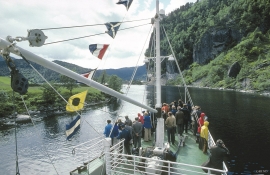Published: 20.02.2013 | Author: Nils Georg Brekke
Mo with the Otterstad farm in the background early in the 1900s. At Mo is stored gravel and sand. (KK Bergen, KK pk 2632, Bs. UBB.)
Just before Christmas 1743 something happened that made a great impact on Otterstad and the Mo farm. This year there was a great flood in the river that tore away a narrow stretch of gravel out by the Mostraumen (Mo current). The sea flooded into what was earlier the Mo Lake, thus transforming it to the Mo Fjord. The shore of the former lake was left lying lower than previously, and the Mo farm acquired new fields towards the fjord; “Nerebøen” (the nether field).
- Litleskare, J. (1933) Mo kyrkja (Moe Capell) og Eksingedalen kyrkja (Fladeqval Capell). Bergen.




